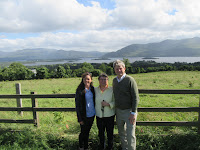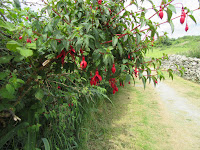It had long been a dream of ours
to see the birthplace of William Shakespeare, and today we would finally do it.
After lunch at the Old Mill Café, we drove 45 minutes to get to Anne Hathaway’s
Cottage. Anne is famous for, in 1582 at the age of 26, marrying the 18-year-old
William Shakespeare while being three months pregnant. Fodor’s calls the cottage “the most
picturesque of the Shakespeare Trust properties.” Anne’s father was a wealthy
sheep farmer who owned about 90 acres of land and a two-room house. The house
was later doubled to its present size, but not while Anne lived there. The
thatched roof of the house is its most prominent feature.
 One of the bedrooms contains a
bed that was reputedly their wedding bed, but not in this house. After the
wedding they lived first with his parents. A chair is reputedly the chair in
which William courted Anne. The Trust has done a nice job of furnishing the
house with period furniture. Guides stationed in the house explained its
history and how it would have looked when Anne lived there. The family continued to occupy the house until
the early 20th century. A beautiful garden behind the house is
planted in Edwardian style. In Anne’s day, it would have been part of the
family’s sheep farm.
One of the bedrooms contains a
bed that was reputedly their wedding bed, but not in this house. After the
wedding they lived first with his parents. A chair is reputedly the chair in
which William courted Anne. The Trust has done a nice job of furnishing the
house with period furniture. Guides stationed in the house explained its
history and how it would have looked when Anne lived there. The family continued to occupy the house until
the early 20th century. A beautiful garden behind the house is
planted in Edwardian style. In Anne’s day, it would have been part of the
family’s sheep farm.
We drove to the Windsor Street
car park, less than a block from Shakespeare’s birthplace. Like the Hathaway
house, the Shakespeare house has been much altered since he lived there. Today
it is a museum honoring the bard and a restoration of an Elizabethan house.
Displayed in the modern visitor center, connected to the house, is a first
folio of Shakespeare’s work. Charles Dickens was involved in preserving the
house as an historical site when it was put up for public auction in 1847.
Next on our itinerary was Holy
Trinity Church, the site of Shakespeare’s grave, as well as the church in which
he was baptized. No one knows where he was married; none of the local churches
have a record of his marriage. Jutting out from the wall above his grave is a
marble bust created in 1626 and thought to be an accurate likeness of him.
We got a great parking place on
the street right outside the Royal Shakespeare Company’s theater and walked up
Sheep Street to our dinner reservation at Lamb’s of Sheep Street. Since the
restaurant didn’t open until 5:00, the time of our reservation, we popped into
the Rose & Crown pub for a drink. We watched some World Cup highlights. At
the half, Uruguay was beating Saudi Arabia 1-0, which turned out to be the
final score. Earlier in the day, Ronaldo had scored a nice header against
Morocco to carry Portugal to a 1-0 victory.
For dinner I had the best lamb
chops ever, Abby enjoyed duck breast, and Chris and Laurie both dined on
lobster thermidor. We dined in half-timbered splendor on the second floor of
Lamb’s. It was a short walk down hill to the Royal Shakespeare Company. We saw
an interesting production of Romeo and Juliet, done in modern attire. Chris and
Laurie had previously played the significant parts of the friar and the nurse
in the play; it was interesting to hear their commentary during the drive home
on darkening roads.
This was our last full day in
Europe. The next day would be a travel day – a 2-1/2 hour drive to Heathrow, a
long wait at the airport, and then an eight-hour flight to MSP. This was a
great trip, and it ended on a high note, a pilgrimage to see Shakespeare’s
birthplace and a modern production of one of his plays. It was a great visit in
the Cotswolds with Chris and Laurie. Ireland was also spectacular, with the
renewal of our wedding vows through an ancient Ogham stone in a 12-century
churchyard. As always, it was with great excitement that we left on this
near-perfect vacation, and now it is with great anticipation that we return
home to the familiar joys of Minnesota – our urban life in St. Paul and our
rural retreat in northern Aitkin County.



















































